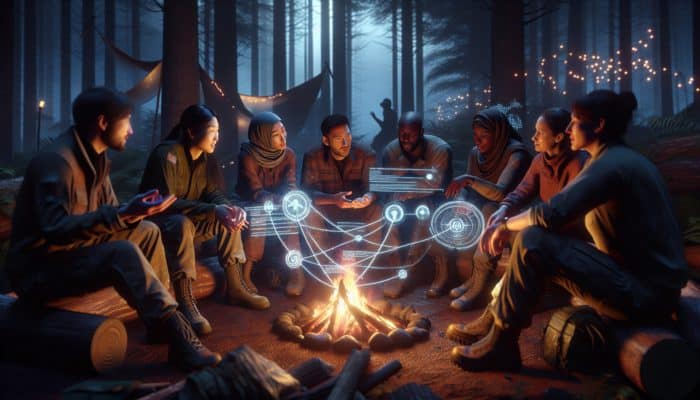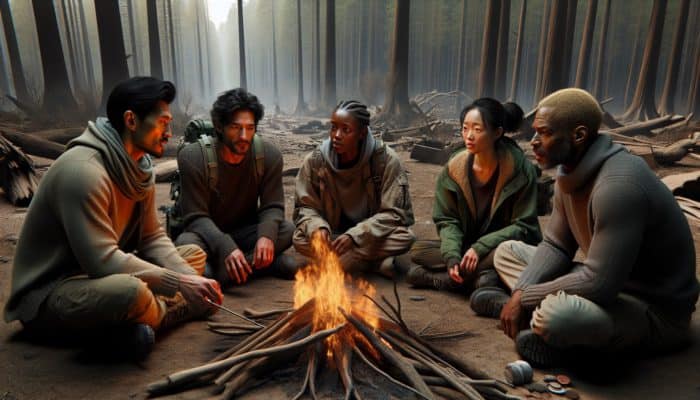Mastering the Essentials of Survival Group Dynamics
Understanding Survival Group Dynamics and Their Significance

Survival Group Dynamics: Understanding survival group dynamics is vital for anyone who may encounter challenging survival situations, whether in remote wilderness areas, during disasters, or in urban environments. This term refers to the interactions and behaviours among individuals within a group who are united by a common survival goal. The significance of these dynamics is profound. Groups that operate effectively typically experience higher survival rates due to improved cooperation, sharing of resources, and emotional support systems. Members of these groups often develop a sense of belonging and purpose, which greatly enhances their psychological resilience and overall ability to cope with adversity.
Survival scenarios frequently heighten stress levels, leading to intense emotions and potential conflicts among group members. The way a group interacts can either intensify these tensions or help alleviate them. Groups that implement clear roles, encourage open communication, and cultivate trust are more adept at managing the complexities of survival situations. By understanding these dynamics, individuals can prepare themselves to contribute positively to group cohesion and effectiveness, ultimately boosting their chances of survival when faced with dire circumstances.
Identifying the Core Components of Effective Survival Groups
Effective survival groups are anchored in several crucial components that bolster their performance under pressure. These elements are foundational to group cohesion and functionality, playing a significant role in achieving survival objectives. To begin with, trust is fundamental; group members must feel secure in their relationships to freely share information and resources. Secondly, clear communication is essential; it ensures that everyone comprehends their roles and the group’s collective goals, leading to more effective coordination and execution.
Another vital component is the presence of diverse skill sets within the group. A blend of skills among members—such as first aid, navigation, shelter construction, and food procurement—facilitates efficient problem-solving and enhances adaptability to various challenges. Moreover, strong leadership can steer the group through crises, helping maintain morale and focus. Lastly, emotional support within the group fosters resilience, enabling individuals to better cope with fear and uncertainty in high-pressure environments.
These components do not operate in isolation; they are interrelated, forming a robust framework for survival. For example, effective communication can strengthen trust, while a diversity of skills can alleviate pressure on leaders, allowing them to delegate tasks more effectively and efficiently.
Defining Group Roles and Responsibilities for Optimal Efficiency
Establishing clear roles within a survival group significantly enhances efficiency and increases the likelihood of success in challenging situations. Every member should have a clear understanding of their designated responsibilities, leading to a more structured approach to survival. Common roles typically include:
- Leader: Guides the group, makes critical decisions, and maintains morale.
- Navigator: Responsible for map reading and route selection to ensure safe travel.
- Medic: Provides basic medical care and first aid in emergencies.
- Forager: Gathers food and identifies safe resources in the environment.
- Builder: Constructs shelters and ensures the group has adequate protection from the elements.
- Communicator: Manages information flow among members and maintains contact with the outside world if possible.
- Cook: Prepares meals and manages food supplies to ensure proper nutrition.
- Scout: Explores ahead for potential dangers or resources and reports back to the group.
Assigning these roles based on individual strengths and preferences can significantly enhance group morale and operational efficiency. When every member is aware of their responsibilities, it not only clarifies tasks but also empowers individuals to take ownership of their contributions. This structured approach is particularly essential in high-stress situations, where clear direction can be the difference between success and failure.
Implementing Effective Communication Strategies for Survival Success

Effective communication serves as a lifeline in survival situations, profoundly impacting a group’s ability to function and thrive. Establishing clear channels of communication can enhance collaboration, reduce misunderstandings, and cultivate a supportive environment. To start, all members should practise active listening, which entails fully concentrating on the speaker, understanding their message, and responding thoughtfully. This practice fosters rapport and ensures that crucial information is not lost in translation.
Another important communication strategy is to employ concise and clear messaging. Survival scenarios often necessitate swift decisions, and ambiguous communication can lead to critical errors. Groups should establish predefined signals or phrases to convey essential information quickly. For example, using terms like “danger” or “need help” can signal immediate threats, facilitating rapid responses.
Regular check-ins among group members also promote transparency and accountability. Encouraging individuals to share their thoughts, feelings, or concerns can strengthen group cohesion and prevent underlying tensions from escalating into conflicts. By nurturing an environment where open communication is encouraged, survival groups can create a more resilient and unified team capable of adapting to challenges as they arise.
Strategies for Effective Conflict Resolution in Survival Groups
Conflict is an unavoidable aspect of group dynamics, particularly in high-pressure survival situations. Effectively managing conflicts is crucial for maintaining group unity and focus on survival objectives. To address and resolve conflicts, groups should utilise a few key methodologies. First, establishing ground rules for discussions can create a safe space for members to express their concerns without fear of backlash. This approach encourages openness and diminishes the likelihood of unresolved resentments building up.
Another effective strategy is to concentrate on the issue rather than the individual. By focusing on the problem at hand instead of personal attributes, groups can facilitate more constructive conversations. Encouraging members to articulate their feelings and perspectives can lead to better understanding and compromise. Additionally, involving a neutral mediator—someone who can facilitate the discussion without bias—can be advantageous for resolving disputes effectively.
Practising empathy is another critical aspect, where group members strive to understand each other’s viewpoints. This practice can de-escalate tensions and foster a collaborative spirit. Ultimately, the objective of conflict resolution in survival groups is not merely to settle disagreements but to strengthen relationships and reinforce the commitment to collective survival.
Insights from Experts on Survival Group Dynamics
Exploring the Psychological Dimensions of Group Survival

The psychological impacts of survival group dynamics profoundly influence individual behaviours and group performance during crises. In survival situations, the stress of uncertainty can lead to heightened emotional responses, which can either bolster group cohesion or fracture relationships. Individuals often experience fear, anxiety, and a sense of helplessness, which can be amplified in group settings. Recognising these psychological aspects is essential for creating a supportive environment.
For example, research has demonstrated that groups tend to provide emotional support, which can enhance individual resilience. When individuals feel understood and supported by their peers, they are more likely to maintain a positive outlook and contribute actively to the group’s efforts. Conversely, if members perceive a lack of support or feel isolated, they may withdraw, resulting in decreased morale and overall effectiveness.
Real-world examples effectively illustrate these psychological dynamics. In survival scenarios such as the 1972 Andes flight disaster, the survivors' capacity to collaborate and support one another was pivotal to their endurance. They forged strong social bonds that aided them in coping with dire circumstances, ultimately leading to their survival. This case underscores the significance of psychological factors in survival group dynamics, highlighting that effective group interactions can mitigate the adverse effects of stress and uncertainty.
Effective Strategies for Conflict Resolution
When conflicts arise within a survival group, it is essential to address them promptly and effectively to maintain focus on collective goals. Several strategies can facilitate conflict resolution. Primarily, groups should encourage open dialogue, allowing members to express their feelings and perspectives. This approach fosters understanding and can lead to collaborative problem-solving.
Another effective strategy is to establish a clear conflict resolution protocol. For instance, groups might agree on a systematic process for addressing disputes, which could include discussing the issue privately first, seeking input from a neutral party, and reaching a consensus on a resolution. This structured methodology can help prevent conflicts from escalating and ensure that all voices are heard.
Additionally, incorporating team-building exercises before crises can strengthen relationships and improve communication skills, making it easier to navigate disagreements when they arise. Training in conflict resolution techniques, such as negotiation and mediation, can also equip group members with the necessary skills to address conflicts constructively.
Finally, maintaining a focus on common goals can help group members stay mindful of the larger picture, promoting unity despite personal differences. By implementing these strategies, survival groups can enhance their ability to resolve conflicts and maintain cohesion in the face of adversity.
Understanding Leadership in Survival Scenarios
Leadership plays a pivotal role in survival scenarios, guiding groups through the complexities of crisis management and sustaining morale. Effective leaders adapt their styles to the needs of the group, particularly during high-stress situations. A successful leader is not only decisive but also empathetic, attuned to the emotional states of group members, and provides the necessary support.
A key aspect of effective leadership in survival situations is the ability to delegate tasks according to individual strengths. This approach empowers group members and fosters a sense of ownership and responsibility among them. Leaders must also communicate effectively, ensuring that everyone comprehends the group’s objectives and their respective roles.
Morale is another critical focus for leaders. During survival situations, maintaining a positive atmosphere can significantly influence group dynamics. Leaders can enhance morale by recognizing individual contributions, promoting group bonding activities, and maintaining transparency about challenges and progress. Moreover, leaders should cultivate a sense of shared purpose, reminding group members of their collective goals and the importance of collaboration.
Real-world examples, such as the leadership demonstrated during the Chilean miners' rescue in 2010, emphasise the importance of strong leadership in survival scenarios. The efforts of leaders both inside and outside the mine were instrumental in maintaining communication and morale, ultimately culminating in a successful rescue operation. This case illustrates the necessity of effective leadership in navigating the complexities of survival dynamics.
Communication Techniques to Enhance Survival Group Dynamics
Effective communication techniques are essential for enhancing group cohesion and decision-making in survival scenarios. A well-coordinated group can respond more efficiently to challenges, leading to improved survival outcomes. One indispensable technique is to establish clear lines of communication. Groups should devise a system for sharing information, employing designated signals or codes for urgent notifications or updates. This clarity reduces confusion and ensures that critical messages are conveyed swiftly.
Encouraging active participation during discussions can further enhance communication flow. By inviting all members to share their thoughts and opinions, groups can leverage diverse perspectives and ideas, leading to more informed, well-rounded decision-making. Additionally, holding regular group meetings to assess progress and address concerns can help maintain alignment and cohesion within the group.
Non-verbal communication also plays a significant role in survival situations. Body language, facial expressions, and even gestures can convey messages when words may not suffice. Training group members to be aware of these non-verbal cues can enhance mutual understanding and support, creating a more cohesive team environment.
Practical examples underscore the power of effective communication in survival scenarios. In wilderness survival courses, instructors emphasise communication exercises that simulate crises, where clear and precise messaging is paramount. These training opportunities equip individuals to navigate real-world challenges effectively, demonstrating the profound impact that robust communication techniques can have on group dynamics and survival outcomes.
How Do Survival Groups Form and Evolve?
The Dynamics of Initial Group Formation
Numerous factors, including shared goals, mutual interests, and situational circumstances, shape the process of forming a survival group. Individuals often seek like-minded peers who can offer complementary skills and emotional support. In situations such as natural disasters or outdoor adventures gone awry, people instinctively gravitate towards those they know or share values with, forming ad-hoc groups based on immediate needs and common objectives.
A critical factor in group formation is the establishment of trust among members. Initial interactions can lay the groundwork for how individuals perceive each other and their willingness to collaborate. Trust can be nurtured through open communication and shared experiences, which swiftly help solidify bonds, particularly in high-stress situations where reliance on one another becomes paramount.
Additionally, leadership may emerge organically as certain individuals take charge based on their expertise or experience. This dynamic can significantly influence group activities and decision-making processes. For instance, in a wilderness survival context, someone with prior outdoor experience may naturally assume a leadership role, affecting how the group approaches challenges and allocates tasks.
In summary, the formation of survival groups is a dynamic process influenced by social ties, emergent leadership, and the immediate context of the survival scenario.
Understanding the Stages of Group Development
Survival groups typically undergo specific stages of development, each characterised by distinct dynamics and challenges. Understanding these stages can aid groups in navigating their evolution and enhancing overall effectiveness. The initial stage is often referred to as forming, where individuals come together, establish roles, and create a foundational understanding of their objectives. During this phase, group members are generally polite and cautious as they assess each other's strengths and weaknesses.
The subsequent stage is often termed storming, characterised by the emergence of conflicts and differences in opinions. This stage can be particularly challenging as group members confront their individual personalities and establish boundaries. Navigating this phase necessitates effective communication and conflict resolution strategies to maintain group cohesion and focus.
As the group progresses, they enter the norming stage, where members begin to collaborate more effectively and establish a sense of unity. As roles become clearer and trust among group members develops, it leads to increased cooperation and shared problem-solving. Finally, the performing stage sees the group operating at its highest level, with members actively working together to achieve survival goals, utilising each other’s strengths to overcome challenges.
It is important to note that these stages are not strictly linear; groups may cycle through them based on evolving circumstances. For example, as new challenges arise, groups may revert to earlier stages, necessitating revisited discussions and role re-evaluations. Understanding these stages enables groups to anticipate challenges and adapt their strategies effectively.
Adapting to Evolving Circumstances in Survival Situations
Survival groups must continuously evolve to meet new challenges and ensure ongoing survival. Adapting to changing circumstances involves reassessing group dynamics, roles, and strategies as situations shift. This adaptability is crucial for maintaining effectiveness and cohesion in unpredictable environments where conditions can change rapidly.
A key aspect of adaptation is flexibility in roles and responsibilities. As situations evolve, groups may need to reassess who is best suited for specific tasks. For instance, an initial navigator may need to step back if another group member gains more relevant experience or skills, emphasising the importance of open communication and trust within the team.
Additionally, survival groups should remain proactive and continuously monitor their environment. New threats, resources, or opportunities can emerge unexpectedly, requiring groups to adjust their strategies accordingly. This proactive approach enhances resilience and positions groups to respond swiftly to challenges, minimising risks.
Moreover, groups should engage in reflective practices, where members discuss what is working and what needs improvement. Regular check-ins allow for the identification of emerging issues and facilitate collective problem-solving efforts. By fostering a culture of adaptability and continuous learning, survival groups can bolster their chances of enduring long-term challenges while maintaining group cohesion.
Leadership and Decision-Making in Survival Groups
Leadership and decision-making within survival groups are critical components that significantly influence group dynamics and overall effectiveness. Effective leaders must navigate group dynamics with sensitivity, recognising the strengths and weaknesses of individual members while fostering a collective sense of purpose. Leadership styles may vary depending on the situation, ranging from authoritative when quick decisions are necessary to participative when consensus is beneficial.
Decision-making processes should be inclusive, allowing all members to contribute their insights and expertise. This collaboration not only enhances decision quality but also fosters a sense of ownership among group members. For instance, in a survival scenario, decisions regarding resource allocation, route selection, or shelter construction should involve input from those with relevant skills, ensuring that choices are well-informed and collectively supported.
Furthermore, leaders should establish a clear framework for decision-making. This could involve setting criteria for evaluating options, discussing potential risks, and agreeing on a timeline for making decisions. A structured approach can streamline the decision-making process, reducing the potential for conflict and confusion within the group.
Ultimately, the interplay between leadership and decision-making shapes the overall effectiveness of survival groups. By cultivating strong leadership and inclusive practices, groups can navigate challenges more effectively and enhance their chances of survival in high-stress situations.
Exploring Group Dynamics and Conflict Resolution
Understanding interpersonal dynamics within survival groups is essential for cultivating a cohesive and effective team. Conflicts can arise from differences in opinions, priorities, and stress levels, but addressing these issues constructively can strengthen group relationships. Recognising that conflicts are a natural part of group dynamics is crucial; the goal should be to resolve disputes while maintaining a focus on shared objectives and overall survival.
One effective strategy for managing group dynamics is to encourage open communication. Providing a safe space for members to express their feelings and opinions can prevent misunderstandings from escalating into larger conflicts. Regular check-ins allow group members to share their concerns and ideas, fostering a sense of unity and transparency.
Employing conflict resolution techniques can also enhance group stability. For instance, recognising and addressing issues early can prevent them from festering and becoming more significant problems. Active listening is vital; allowing individuals to voice their concerns without interruption can help diffuse tensions and foster mutual understanding among group members.
Moreover, establishing a culture of empathy within the group can strengthen relationships and promote collaboration. Encouraging members to consider each other’s perspectives can lead to more constructive conversations and resolutions. By cultivating these dynamics, survival groups can enhance their resilience, enabling them to navigate challenges more effectively and maintain a united front in the face of adversity.
Research-Backed Advantages of Survival Group Dynamics
Boosting Survival Rates through Effective Group Dynamics
Being part of a well-functioning group significantly increases both individual and collective survival rates. Research reveals that groups that communicate effectively and collaborate seamlessly tend to achieve better outcomes in crises. Statistical data support this claim, showing that groups often outperform individuals, particularly in high-stress environments. For instance, studies conducted during wilderness survival training consistently demonstrate that participants in groups achieve higher success rates than their solo counterparts.
This enhanced survival can be attributed to various factors. Firstly, groups can pool their resources and skills, leading to more efficient problem-solving and decision-making. This collective intelligence enables members to tackle challenges that might overwhelm an individual acting alone. Additionally, the emotional support provided by group members can serve as a buffer against stress, ultimately resulting in improved mental health and resilience during crises.
Moreover, research indicates that groups with established roles and clear communication strategies perform better under pressure. Groups that engage in regular training and simulations often develop these essential skills, enhancing their preparedness and adaptability when faced with real-world challenges. Overall, the evidence strongly supports the notion that effective survival group dynamics can dramatically enhance survival outcomes across various scenarios.
Maximising Resource Management in Group Settings
Group resource management offers distinct advantages compared to individual efforts, particularly in survival scenarios. When individuals collaborate effectively, they can optimise resource allocation and minimise waste. Groups can share tools, knowledge, and skills, leading to a more efficient approach to challenges such as food procurement, shelter construction, and navigation.
For example, in a survival context, a group of individuals may divide tasks based on their strengths, with one member focusing on foraging while another constructs shelter. This division of labour enables the group to achieve more in a shorter amount of time compared to individuals tackling these tasks independently. By pooling resources, groups can also prepare for unexpected challenges, such as identifying additional food sources or creating contingency plans.
Furthermore, collaborative resource management fosters a sense of accountability among group members. When everyone has a stake in the group's survival, individuals are more likely to contribute effectively and monitor resource usage. This collective approach can lead to more sustainable practices and better long-term outcomes. Overall, group resource management enhances efficiency, fosters cooperation, and improves the likelihood of survival in challenging situations.
Providing Emotional and Psychological Support within Survival Groups
The role of group dynamics in providing emotional support is crucial for maintaining mental health during survival situations. High-stress environments can lead to feelings of isolation, anxiety, and despair. However, being part of a supportive group can counteract these negative effects, enhancing overall well-being and resilience among members.
Survival groups often cultivate a sense of belonging, fostering connections among members that can provide comfort and encouragement. This emotional support can manifest in various forms, such as sharing experiences, offering reassurance, and providing a listening ear. In high-pressure situations, these interactions can significantly alleviate stress and promote mental stability, allowing individuals to function more effectively.
Furthermore, group dynamics can facilitate the processing of emotions and coping with challenges. Engaging in collective problem-solving allows members to share burdens and brainstorm solutions, reducing the sense of helplessness that can accompany isolation. Real-world examples, such as support networks formed during natural disasters, illustrate the profound impact of emotional support in survival scenarios. These networks frequently emerge organically, demonstrating the innate human need for connection and community during times of crisis.
In conclusion, the emotional and psychological benefits derived from effective group dynamics are essential for navigating the complexities of survival situations, fostering resilience, and enhancing overall outcomes for all members involved.
Leveraging Increased Skill Diversity for Survival Success
Survival groups that incorporate diverse skill sets significantly improve their chances of overcoming challenges. When individuals bring unique competencies to the group, it allows for a more comprehensive approach to survival tasks, leading to greater efficiency. A mix of skills—ranging from medical knowledge and navigation to foraging and shelter-building—enables groups to tackle various situations that may arise effectively.
For instance, during outdoor survival courses, participants are often grouped based on their skill sets. Teams consisting of individuals with complementary skills—such as a medic, navigator, and builder—typically excel compared to those with a homogenous skill set. This diversity allows for a more well-rounded response to challenges, as group members can rely on each other’s expertise in specific areas.
Moreover, skill diversity fosters innovation and creativity within the group. When individuals with different backgrounds and experiences collaborate, they can generate novel solutions to challenges. This collaborative effort not only enhances problem-solving capabilities but also promotes adaptability, which is crucial in survival scenarios where conditions can change rapidly.
In summary, increased skill diversity within survival groups leads to better outcomes by enabling efficient task allocation, fostering creativity, and enhancing adaptability in the face of unforeseen challenges.
Strengthening Decision-Making Processes within Groups
Collective decision-making processes in survival scenarios yield numerous benefits, particularly concerning effectiveness and safety. Groups that engage in collaborative decision-making strategies are often better equipped to assess risks and explore options more comprehensively. The diverse perspectives offered by different members can lead to well-rounded decisions, reducing the likelihood of oversights that might occur when decisions are made unilaterally.
One significant advantage of group decision-making is the ability to leverage individual expertise. In a survival context, group members may possess specialised knowledge in areas such as first aid, navigation, or resource procurement. By encouraging all members to contribute to discussions, groups can harness this collective intelligence, leading to more informed and effective choices.
Moreover, consensus-based decision-making fosters a sense of ownership and commitment among group members. When individuals feel that their opinions are valued, they are more likely to commit to the chosen course of action and actively support its implementation. This commitment can be crucial in survival situations, where adherence to a plan may mean the difference between success and failure.
Real-world examples illustrate the effectiveness of collective decision-making in survival scenarios. Groups involved in wilderness survival training often demonstrate improved outcomes when practising collaborative decision-making techniques during simulated emergencies. These experiences help groups develop the skills necessary to navigate real-world challenges more effectively, showcasing the importance of robust decision-making processes in enhancing survival outcomes.
What Challenges Do Survival Groups Encounter with Dynamics?
Navigating the Management of Diverse Personalities
Managing diverse personalities within a survival group presents a unique set of challenges. Individuals bring different temperaments, communication styles, and coping mechanisms, which can lead to both constructive collaboration and potential conflicts. Understanding these dynamics is vital for fostering a cohesive and effective team.
To address personality diversity, group members should practise empathy and active listening. Encouraging individuals to express their feelings and perspectives openly can help build understanding and rapport. Establishing ground rules for communication can also create a safe environment for discussions, allowing members to navigate differences in styles without escalating tensions.
Another effective strategy is to recognise and value each member’s strengths. By emphasising the contributions that each personality brings to the group, members can cultivate mutual respect and appreciation. For instance, a more assertive personality may excel in leadership roles, while a more thoughtful individual may contribute valuable insights during decision-making discussions.
Additionally, implementing team-building exercises can help bridge personality gaps and enhance group dynamics. These activities create opportunities for individuals to bond and develop trust, ultimately resulting in a more cohesive and effective team. By proactively managing diverse personalities, survival groups can harness the benefits of varied perspectives while minimising potential conflicts that could undermine group cohesion.
Strategies for Maintaining Group Cohesion
Maintaining group cohesion in survival scenarios is essential for achieving common goals and improving overall survival outcomes. As challenges arise, tensions can escalate, threatening the unity of the group. To prevent fragmentation, several strategies can be employed to keep members focused on shared objectives and collaborative efforts.
First and foremost, establishing clear communication channels is crucial. Open lines of communication facilitate transparency, allowing members to express concerns and provide feedback. Regular check-ins can help identify emerging issues before they escalate, enabling the group to address concerns collaboratively and promptly.
Fostering a sense of shared purpose also reinforces group cohesion. Reminding members of their collective goals and the importance of collaboration can help realign focus during times of stress. Celebrating small victories and acknowledging individual contributions can further boost morale and strengthen bonds among members.
Moreover, engaging in team-building activities can significantly enhance cohesion. Activities that promote trust and cooperation—such as problem-solving exercises or group challenges—encourage members to work together and develop relationships. By investing in group cohesion, survival groups can cultivate a resilient team capable of navigating challenges more effectively and achieving their survival objectives.
Optimising Decision-Making Processes for Survival Groups
Effective decision-making processes are critical for survival group dynamics, impacting both group cohesion and survival outcomes. The challenges of making decisions in high-pressure scenarios can lead to disagreements, frustration, and even conflict. Establishing a structured decision-making framework can alleviate some of these challenges and promote more effective collaboration.
One key aspect of decision-making is inclusivity. Encouraging all group members to participate ensures that diverse perspectives are considered, leading to more informed choices. This approach helps prevent resentment from individuals who might feel marginalised or overlooked during discussions.
Setting clear criteria for evaluating options can also enhance decision-making efficacy. Groups should establish guidelines to assess potential courses of action, considering factors such as feasibility, risks, and potential benefits. This structured approach can streamline discussions and reduce the likelihood of indecision or conflict.
Additionally, leaders should be prepared to facilitate discussions, ensuring that all voices are heard and respected. Effective leadership can guide the group through disagreements, helping members navigate their differences constructively and collaboratively. By prioritising effective decision-making processes, survival groups can enhance their unity, focus, and overall performance in challenging situations.
Proven Strategies for Enhancing Survival Group Dynamics
Building Trust and Fostering Open Communication
Building trust and effective communication within a survival group is fundamental to achieving cohesion and success. Trust fosters an environment where group members feel safe to express themselves, share ideas, and rely on one another during crises. Establishing trust begins with transparency; leaders should encourage open communication and honesty, setting a positive tone for interactions within the group.
One actionable step to foster trust is to create opportunities for team bonding. Organising shared activities—such as team-building exercises or social gatherings—can help members connect on a personal level, strengthening relationships. These informal interactions build rapport and create a foundation for trust that pays dividends during high-stress situations.
Moreover, practising active listening and empathy during discussions can enhance communication and build trust. When members feel heard and understood, they are more likely to reciprocate these behaviours, fostering a positive feedback loop. Additionally, establishing ground rules for respectful communication can help maintain a supportive atmosphere, particularly during disagreements and discussions about sensitive topics.
Regularly reviewing and reflecting on group interactions can also foster continuous improvement. Encouraging members to provide feedback on communication practices and team dynamics supports a culture of growth and adaptability. By prioritising trust and communication, survival groups can create a strong support network that enhances overall performance and resilience in challenging situations.
Prioritising Training and Skill Development for Group Success
Ongoing training and skill development are vital for ensuring a survival group's effectiveness. In high-pressure situations, having individuals equipped with the necessary skills can significantly influence overall outcomes. Therefore, groups should prioritise training in essential areas relevant to their survival context.
First, identifying key skills required for survival is crucial. These may include first aid, navigation, shelter building, and foraging. Training sessions should be organised to ensure that all members possess a foundational understanding of these skills, allowing for greater collaboration and knowledge-sharing among the group.
Moreover, conducting regular drills and simulations can help groups practise their skills in controlled environments. These exercises prepare individuals for real-world challenges, improving their confidence and competence during actual survival scenarios. Additionally, inviting experienced instructors to conduct training sessions can provide valuable insights and enhance learning opportunities for all members.
Lastly, fostering a culture of continuous learning is essential. Encouraging members to share new information, techniques, or resources promotes skill development and maintains the group's adaptability. By investing in ongoing training and skill development, survival groups can enhance their overall readiness and effectiveness in navigating complex survival scenarios.
Preparing for Long-Term Survival in Challenging Environments
Ensuring a survival group's viability over extended periods requires thoughtful planning and strategic foresight. Long-term survival necessitates a holistic approach to resource management, group cohesion, and adaptability. Groups should begin by assessing their environment and identifying potential resources—such as water sources, food availability, and shelter options.
Strategic resource management is vital for sustainable survival. Groups should develop plans for rationing supplies, tracking usage, and identifying alternative sources of sustenance. Creating a resource inventory can support effective management and prevent waste, ensuring that the group can sustain itself over time.
Moreover, establishing routines fosters stability, enhancing group morale and cohesion. Regular schedules for tasks—such as food procurement, shelter maintenance, and communication check-ins—create a sense of normalcy amidst uncertainty. These routines encourage members to contribute actively, reinforcing their commitment to the group's well-being and survival.
Finally, groups must remain adaptable, ready to pivot their strategies as circumstances change. Engaging in collective discussions about challenges and opportunities can facilitate ongoing adaptation and resilience in the face of new obstacles. By prioritising long-term survival planning, groups can enhance their chances of thriving in challenging environments and successfully navigate the complexities of survival dynamics.
Frequently Asked Questions about Survival Group Dynamics
What are survival group dynamics?
Survival group dynamics refer to the interactions and behaviours among individuals within a group working together towards survival goals. These dynamics encompass communication, trust, roles, and conflict resolution, all of which significantly impact the overall effectiveness of a group.
Why is trust important in survival groups?
Trust fosters open communication, collaboration, and emotional support among group members, enhancing group cohesion and improving the chances of survival. When members feel secure in their relationships, they are more likely to share resources and information effectively.
What roles should be established in a survival group?
Common roles include leader, navigator, medic, forager, builder, communicator, cook, and scout. Defining these roles enhances group efficiency and allows members to focus on their strengths, improving the overall functioning of the group during survival scenarios.
How can conflicts be resolved in survival situations?
Conflicts can be resolved by encouraging open dialogue, focusing on the issue rather than personal attributes, and employing a neutral mediator if necessary. Establishing ground rules for discussions can also create a safe environment for conflict resolution, promoting constructive conversations.
What are the psychological impacts of survival group dynamics?
Survival group dynamics can significantly influence individual and collective psychology. Effective groups provide emotional support, mitigating stress and anxiety, while poorly functioning groups can lead to isolation and decreased morale among members.
How do survival groups form?
Survival groups often form based on shared goals, mutual interests, and situational circumstances. Individuals gravitate towards those they know or share values with, forming ad-hoc groups during crises or challenging survival situations.
What are the stages of group development?
Survival groups typically progress through stages of forming, storming, norming, and performing. Each stage presents unique dynamics and challenges, influencing how groups interact and function collectively.
Why is skill diversity important in survival groups?
Increased skill diversity enhances a group's ability to tackle various challenges by covering more essential tasks. Groups with varied skills can leverage individual strengths, leading to more effective problem-solving and adaptability to changing circumstances.
How can survival groups prepare for long-term survival?
Preparing for long-term survival involves strategic resource management, establishing routines, and remaining adaptable to changing circumstances. Groups should conduct regular assessments of their environment to identify essential resources and develop sustainable survival plans.
What is the role of leadership in survival groups?
Leadership is critical in guiding a group through challenges, maintaining morale, and facilitating effective communication. A successful leader adapts their style based on the group's needs, fostering collaboration and informed decision-making.
Explore our world on X!
Survival Group Trust: Building Strong Bonds
Understanding the Crucial Role of Trust in Survival Groups What Factors Contribute to Building Trust Within a Group? Survival Group Trust: The foundation of any successful survival group. When trust is lacking, group members may struggle to collaborate effectively, severely compromising their chances of success in critical situations. Several key factors contribute to establishing trust […]
Prepper Support Networks: Building Resilient Communities
Understanding the Dynamics of Prepper Support Networks What Exactly Are Prepper Support Networks? Prepper Support Networks: Prepper support networks consist of collaborative communities formed by individuals who prioritise preparedness for a range of emergencies and disasters. These networks focus on teamwork, resource sharing, and knowledge exchange to enhance resilience and promote self-sufficiency during challenging situations. […]
Prepper Teamwork Ideas: Building Strong Communities
Creating High-Performing Prepper Teams for Emergency Preparedness Clearly Defining Team Roles and Responsibilities for Success Prepper Teamwork Ideas: Establishing clear roles within a prepper team is paramount to ensuring that every member understands their specific duties, thereby enhancing overall operational effectiveness. By assigning distinct roles — such as team leader, medic, logistics coordinator, and security officer —the […]
Prepper Unity Strategies: Building Strong Communities
Building Strong Foundations for Unity in Prepper Communities Essential Principles That Foster Community Unity Prepper Unity Strategies: Understanding the fundamental values that promote unity among preppers is vital for creating robust and resilient communities. These core values encompass shared responsibility, mutual support, respect for Diversity, and a commitment to collective goals. When individuals unite under […]







I really appreciate how you’ve delved into the intricacies of survival group dynamics. It’s fascinating how the human experience shifts under pressure, isn’t it? Your point about the emotional support system within these groups struck a chord with me. I can’t help but think back to stories I’ve read about survival situations where the psychological aspect is just as critical as physical endurance.